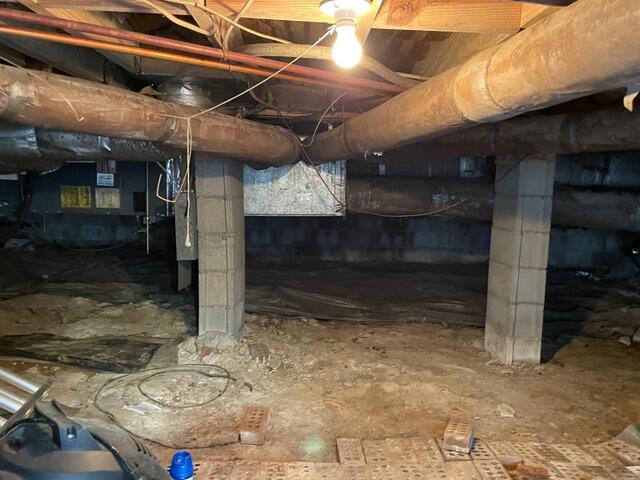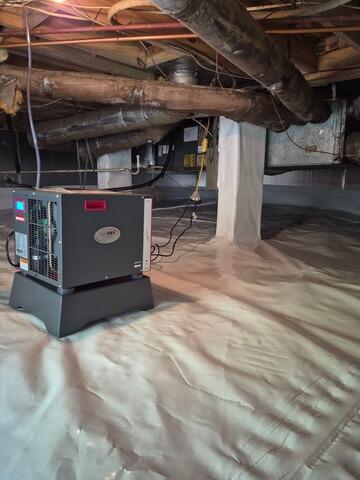Carolina Basement Systems Before & After Photos
Click on a photo to enlarge.
Crawl Space Repair in Browns Summit, NC
Full of garbage, torn plastic, and experiencing early signs of water seepage this crawl space facilitated a less than desirable atmosphere. For a home, the crawl space is very important to keep dry and maintain good air quality that flows through the rest of the house. We were able to remove the debris and protect this home by waterproofing it, installing a vapor barrier, and a dehumidifier.
Insulation and Vapor Barrier Installation in Graham, NC Crawl Space
Short term solutions inside a crawl space, like fiberglass insulation, consistently fail homes just like this one. To provide a more durable system we installed thermal insulation along the walls of the crawl space, instead of below the first level’s floor, and wrapped It in CleanSpace vapor barrier. Now the air inside the crawl space can be more accurately monitored and controlled.
Concealing Interior Waterproofing in Eden, NC
This basement was experiencing mold growth from constant water intrusion and was being used mainly for storage for the homeowners. Our interior waterproofing system using WaterGuard along the edge of the block wall works perfectly. It keeps the water from idling and building up inside the wall and fits along the perimeter being almost entirely concealed and able store items on top of it after installation.
Wall Crack Repair in North Wilkesboro, NC
This exterior wall had a large staircase crack going up the side due to shifting and settlement within the foundation. Our well-trained team of professionals installed helical piers to permanently stabilize the foundation slab and used Poly to seal the exterior cracks in the bricks.
Creating a Healthier Home from the Ground Up in Greensboro, NC
This Greensboro, NC home was facing common crawl space issues excess moisture, exposed dirt, and poor air circulation. The damp environment was contributing to musty odors, inefficient energy use, and the risk of mold and structural damage.
To solve the problem, our team encapsulated the entire crawl space with a durable vapor barrier, creating a clean and sealed environment. A SaniDry dehumidifier was also installed to actively control humidity levels and improve air quality throughout the home.
Now, this crawl space is clean, dry, and protected helping to boost home health, energy efficiency, and long-term structural stability.
our service area
We serve the following areas
- Bakersville
- Banner Elk
- Blowing Rock
- Boomer
- Boone
- Burnsville
- Collettsville
- Creston
- Crossnore
- Crumpler
- Deep Gap
- Elk Park
- Ferguson
- Fleetwood
- Glen Alpine
- Glendale Springs
- Granite Falls
- Grassy Creek
- Green Mountain
- Hot Springs
- Hudson
- Jefferson
- Jonas Ridge
- Lansing
- Laurel Springs
- Lenoir
- Linville
- Marion
- Mars Hill
- Marshall
- Mc Grady
- Micaville
- Millers Creek
- Minneapolis
- Montezuma
- Morganton
- Nebo
- Newland
- Pineola
- Piney Creek
- Plumtree
- Purlear
- Scottville
- Spruce Pine
- Sugar Grove
- Todd
- Vilas
- Warrensville
- West Jefferson
- Zionville










